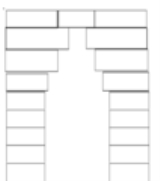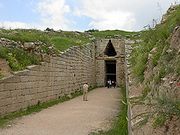
Corbel arch
Encyclopedia
 |
|
| Basic principle of corbeled arch design. | Comparison of a corbel arch (right) and a generic "true" stone arch Arch An arch is a structure that spans a space and supports a load. Arches appeared as early as the 2nd millennium BC in Mesopotamian brick architecture and their systematic use started with the Ancient Romans who were the first to apply the technique to a wide range of structures.-Technical aspects:The... (left). |
A corbel arch (or corbeled / corbelled arch) is an arch-like construction method that uses the architectural
Architecture
Architecture is both the process and product of planning, designing and construction. Architectural works, in the material form of buildings, are often perceived as cultural and political symbols and as works of art...
technique of corbel
Corbel
In architecture a corbel is a piece of stone jutting out of a wall to carry any superincumbent weight. A piece of timber projecting in the same way was called a "tassel" or a "bragger". The technique of corbelling, where rows of corbels deeply keyed inside a wall support a projecting wall or...
ing to span a space or void in a structure, such as an entranceway in a wall or as the span of a bridge. A corbel vault uses this technique to support the superstructure of a building's roof.
A corbel arch is constructed by offsetting successive courses of stone at the springline of the walls so that they project towards the archway's center from each supporting side, until the courses meet at the apex of the archway (often capped with flat stones). For a corbeled vault covering the technique is extended in three dimensions along the lengths of two opposing walls.
Although an improvement in load-bearing efficiency over the post and lintel
Post and lintel
Post and lintel, or in contemporary usage Post and beam, is a simple construction method using a lintel, header, or architrave as the horizontal member over a building void supported at its ends by two vertical columns, pillars, or posts...
design, corbeled arches are not entirely self-supporting structures, and it is sometimes termed a "false arch" for this reason. Unlike "true" arch
Arch
An arch is a structure that spans a space and supports a load. Arches appeared as early as the 2nd millennium BC in Mesopotamian brick architecture and their systematic use started with the Ancient Romans who were the first to apply the technique to a wide range of structures.-Technical aspects:The...
es, not all of the structure's tensile stresses caused by the weight of the superstructure are transformed into compressive stresses. Corbel arches and vault
Vault (architecture)
A Vault is an architectural term for an arched form used to provide a space with a ceiling or roof. The parts of a vault exert lateral thrust that require a counter resistance. When vaults are built underground, the ground gives all the resistance required...
s require significantly thickened walls and an abutment
Abutment
An abutment is, generally, the point where two structures or objects meet. This word comes from the verb abut, which means adjoin or having common boundary. An abutment is an engineering term that describes a structure located at the ends of a bridge, where the bridge slab adjoins the approaching...
of other stone or fill to counteract the effects of gravity, which otherwise would tend to collapse each side of the archway inwards.
Use in historical cultures


Ireland
The NewgrangeNewgrange
Newgrange is a prehistoric monument located in County Meath, on the eastern side of Ireland, about one kilometre north of the River Boyne. It was built around 3200 BC , during the Neolithic period...
passage tomb has an intact corbel arch supporting the roof of the main chamber, dating from about 3000BC.
Ancient Egypt
Egyptian pyramids from around the time of SneferuSneferu
Sneferu, also spelled as Snephru, Snefru or Snofru , was the founder of the Fourth dynasty of Egypt. Estimates of his reign vary, with for instance The Oxford History of Ancient Egypt suggesting a reign from around 2613 BC to 2589 BC, a reign of 24 years, while Rolf Krauss suggests a 30-year reign...
used corbel vaults in some of their chambers. These include the Bent Pyramid
Bent Pyramid
The Bent Pyramid is an ancient Egyptian pyramid located at the royal necropolis of Dahshur, approximately 40 kilometres south of Cairo, built under the Old Kingdom Pharaoh Sneferu...
and the Red Pyramid
Red Pyramid
The Red Pyramid, also called the North Pyramid, is the largest of the three major pyramids located at the Dahshur necropolis. Named for the rusty reddish hue of its stones, it is also the third largest Egyptian pyramid, after those of Khufu and Khafra at Giza. At the time of its completion, it was...
.
Ancient Greece
The ruins of ancient MycenaeMycenae
Mycenae is an archaeological site in Greece, located about 90 km south-west of Athens, in the north-eastern Peloponnese. Argos is 11 km to the south; Corinth, 48 km to the north...
feature many corbel arches and vaults, the "Treasury of Atreus" being a prominent example. The Arkadiko Bridge
Arkadiko Bridge
The Arkadiko Bridge or Kazarma Bridge is a Mycenaean bridge near the modern road from Tiryns to Epidauros on the Peloponnese, Greece. Dating to the Greek Bronze Age, it is one of the oldest arch bridges still in existence and use....
is one of four Mycenean corbel arch bridges part of a former network of roads, designed to accommodate chariots, between Tiryns
Tiryns
Tiryns is a Mycenaean archaeological site in the prefecture of Argolis in the Peloponnese, some kilometres north of Nauplion.-General information:...
to Epidauros in the Peloponnese
Peloponnese
The Peloponnese, Peloponnesos or Peloponnesus , is a large peninsula , located in a region of southern Greece, forming the part of the country south of the Gulf of Corinth...
, in Greece
Greece
Greece , officially the Hellenic Republic , and historically Hellas or the Republic of Greece in English, is a country in southeastern Europe....
. Dating to the Greek Bronze Age
Bronze Age
The Bronze Age is a period characterized by the use of copper and its alloy bronze as the chief hard materials in the manufacture of some implements and weapons. Chronologically, it stands between the Stone Age and Iron Age...
(13th century BC), it is one of the oldest arch bridges still in existence and use. The well-preserved hellenistic Eleutherna Bridge
Eleutherna Bridge
The Eleutherna Bridge is an ancient Greek corbel arch bridge near the Cretan town of Eleutherna, Greece.The well-preserved structure has a single span of 3.95 m, which is quite large for a false arch. The opening is cut from the unmortared limestone blocks in the shape of an isosceles...
on Crete
Crete
Crete is the largest and most populous of the Greek islands, the fifth largest island in the Mediterranean Sea, and one of the thirteen administrative regions of Greece. It forms a significant part of the economy and cultural heritage of Greece while retaining its own local cultural traits...
has an unusually large span of nearly 4 m.
Maya civilization
Corbeled arches are a distinctive feature of certain pre-ColumbianPre-Columbian
The pre-Columbian era incorporates all period subdivisions in the history and prehistory of the Americas before the appearance of significant European influences on the American continents, spanning the time of the original settlement in the Upper Paleolithic period to European colonization during...
Mesoamerica
Mesoamerica
Mesoamerica is a region and culture area in the Americas, extending approximately from central Mexico to Belize, Guatemala, El Salvador, Honduras, Nicaragua, and Costa Rica, within which a number of pre-Columbian societies flourished before the Spanish colonization of the Americas in the 15th and...
n constructions and historical/regional architectural styles, particularly in that of the Maya civilization
Maya civilization
The Maya is a Mesoamerican civilization, noted for the only known fully developed written language of the pre-Columbian Americas, as well as for its art, architecture, and mathematical and astronomical systems. Initially established during the Pre-Classic period The Maya is a Mesoamerican...
. The prevalence of this spanning technique for entrances and vaults
Vault (architecture)
A Vault is an architectural term for an arched form used to provide a space with a ceiling or roof. The parts of a vault exert lateral thrust that require a counter resistance. When vaults are built underground, the ground gives all the resistance required...
in Maya architecture
Maya architecture
A unique and spectacular style, Maya architecture spans several thousands of years. Often the most dramatic and easily recognizable as Maya are the stepped pyramids from the Terminal Pre-classic period and beyond. Being based on the general Mesoamerican architectural traditions these pyramids...
is attested at a great many Maya archaeological sites, and is known from structures dating back to the Formative
Mesoamerican chronology
Mesoamerican chronology divides the history of pre-Columbian Mesoamerica into several periods: the Paleo-Indian , the Archaic , the Preclassic , the Classic , and the Postclassic...
or Preclassic era. By the beginning of the Classic era (ca. 250 CE
Common Era
Common Era ,abbreviated as CE, is an alternative designation for the calendar era originally introduced by Dionysius Exiguus in the 6th century, traditionally identified with Anno Domini .Dates before the year 1 CE are indicated by the usage of BCE, short for Before the Common Era Common Era...
) corbeled vaults are a near-universal feature of building construction in the central Petén Basin
Petén Basin
The Petén Basin is a geographical subregion of Mesoamerica, located in the northern portion of the modern-day nation of Guatemala, and essentially contained within the department of El Petén...
region of the central Maya lowlands.
India
Before the true arch was introduced by the Romans, the arches in Indian buildings were trabeated or corbelled. In North India in the state of Orissa, "the later temples at Bhubaneswar were built on the principle of corbelled vaulting, which is seen first in the porch of the Mukteswar [a temple said to epitomize N. Indian architecture, circa 950 AD] and, technically speaking, no fundamental change occurred from this time onwards." The tomb of Sultan Ghori is an example of a corbelled arch from 1231 AD, located in New Delhi, India.Cambodia
All the temples in AngkorAngkor
Angkor is a region of Cambodia that served as the seat of the Khmer Empire, which flourished from approximately the 9th to 15th centuries. The word Angkor is derived from the Sanskrit nagara , meaning "city"...
made use of the corbel arch, between the AD 9th and 12th centuries.

